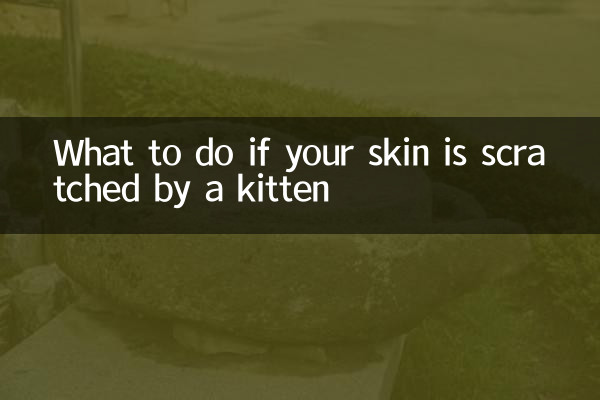What to do if your skin is scratched by a kitten
Recently, pet-related health topics have become increasingly popular on social media. In particular, "how to deal with skin scratches by kittens" has become the focus of many pet owners. The following is a structured guide based on hot topics across the Internet in the past 10 days to help you deal with this problem scientifically.
1. Emergency treatment steps after a kitten is scratched

| step | Operating Instructions | Things to note |
|---|---|---|
| 1. Clean the wound | Immediately rinse with running water and soap for 15 minutes | Avoid using alcohol to directly irritate the wound |
| 2. Disinfection | Use iodophor or medical alcohol cotton balls for ring disinfection | Wipe from the center of the wound outwards |
| 3. Hemostatic dressing | Apply gentle pressure with sterile gauze to stop bleeding and cover the wound | Keep it breathable and avoid sealing bandages |
2. Response plans for different risk levels
| risk level | Wound characteristics | Handling suggestions |
|---|---|---|
| low risk | Slight scratches on the epidermis, no bleeding | 72 hours of home observation |
| medium risk | Penetrates the dermis with a small amount of bleeding | Get tetanus vaccine within 24 hours |
| high risk | Deep laceration, heavy bleeding | Immediate medical attention + rabies immune globulin injection |
3. Infection symptoms that require vigilance
According to the latest data from the Centers for Disease Control and Prevention, about 18% of cat scratches will result in secondary infection. Seek medical attention immediately if you develop the following symptoms:
4. Comparison of recommendations from authoritative organizations
| mechanism | Rabies vaccine recommendations | Tetanus vaccine recommendations |
|---|---|---|
| WHO | Domestic cats that have been vaccinated can be observed for 10 days | If you have not been vaccinated within 5 years, you need to strengthen the vaccination |
| China CDC | Stray cat scratches require immediate vaccination | All penetrating wounds require vaccination |
5. Preventive measures
1. Trim your cat’s nails regularly (recommended once every 2 weeks)
2. Use interactive toys such as cat sticks when playing
3. Gentle desensitization training for kittens during kitten stage
4. High-risk groups (immune deficiencies) are recommended to wear protective gloves
6. Netizens hotly discuss QA selections
Q: Do I need an injection if I am scratched by a 3-month-old kitten?
A: It needs to be combined with the cat’s vaccination status. If the female cat has not been vaccinated or the source of the cat is unknown, it is recommended to treat it as post-exposure prophylaxis.
Q: What should I do if the wound becomes itchy after scabbing?
A: This is a normal healing phenomenon. You can apply Vaseline to moisturize and avoid scratching. If accompanied by redness and swelling, an allergic reaction should be investigated.
Recently, animal behavior experts have put forward a new point of view: Cats scratching people more often is related to stress release. It is recommended to reduce the occurrence of such incidents by increasing vertical space and providing scratching boards. Data shows that environmental enrichment measures can reduce cat aggressive behavior by 40%.
Final reminder: This article is for reference only. Please follow your doctor’s advice for specific treatment. Collect and repost so that more shit-eating officers can see this practical guide!

check the details

check the details